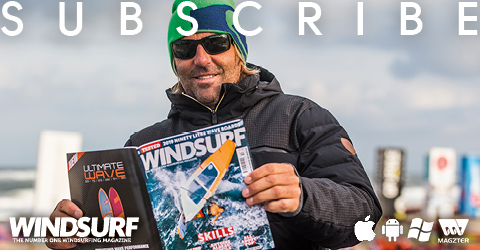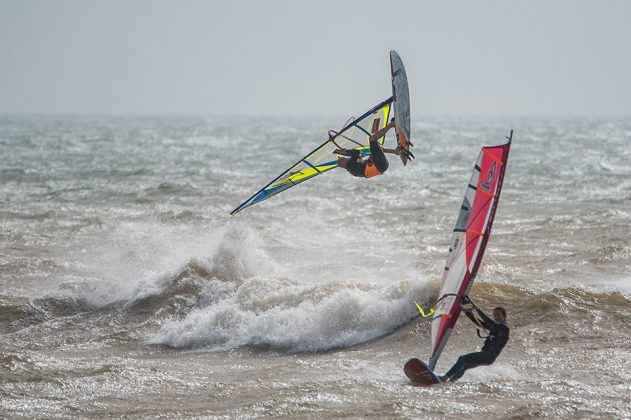JEM HALL
MOVE ON UP – WINDSURFING TECHNIQUE
WAVE BOARD TUNING
I have previously highlighted how one of the ‘greyer’ areas of our sport is kit tuning. So as we welcome spring, I examine how to get the very best out of our wave boards, explaining what we can change to extract better performance across a range of conditions and levels. You can also refer back to previous pieces on tuning Freemoves and FSW’s for reflection and comparison.
With Jem Hall // Photos Nicolas Jones & Si Crowther.
www.jemhall.com
(This feature originally appeared in the April 2019 issue of Windsurf Magazine. To read more features like this first, Print and Digital subscriptions are available.
Prices include delivery globally for 10 x issues a year!)
THE BASICS
Here I will remind you what exactly can we can tune and to what outcome:
• Footstrap size – I always reinforce the fact that big (generous) is beautiful and that it is a ‘footstrap’ and not a ‘toe strap’. Bigger footstraps help you slip your feet in and out smoothly, carve the board and lastly improve your wind range. In wavesailing bigger straps mean you can bail out of jumps, trim the rail better in the air or disengage mid-wipeout and it is also easier to feel the change in carving from back to front foot too.
• Footstrap position – Changing the strap position has several effects: helps make our boards more comfortable for our own stature, gives more control over the board, allows us to prioritise speed or moves, and can place them in a more suitable position for your ability. No two brands have the same spread between the front and back straps, so a tape measure is the truth and your friend. A suggested spread and position of your straps is presented in the picture captions. NOTE: wave boards have a great variation of spread and position so it is much more of a minefield than other types of board.
• Mastfoot position – This is an easy change and can yield a huge difference in performance. Moving it controls the pitch of the board; essentially nudging the mast foot forward locks the board down and bringing it back lifts the nose. Find your 130 cm point (distance from the tail) and mark it. Note some brands have this marked already, but it is worth double-checking. Again please experiment to find an all-round setting and move the mastfoot fore and aft by a cm or 2 – no more. Mastfoot boxes are moving further and further back so be aware of this and don’t be shocked to be running your position at 125 cm from the tail.
• Fin Size – Size matters with fins and wave boards are no exception. For example, on tri-fins you could be running with 3 different sized back (centre) fins in your fin quiver to great effect, although 2 is more common. Increasing fin size ups the lift, assists early planing and upwind sailing while also providing more drive, and potentially grip. This grip can be very useful for learning to ride and also for when more experienced riders are carving harder on bigger waves at more speed. Decreasing fin size lessens the lift and helps the board to become more controllable and manoeuvrable. Some brands can have huge centre fins (in a tri-fin setup) in their boards that once you are at a certain level are just too big, and sizing down will really help you, vice versa may also be the case. An increase in looseness can also help experienced riders who are looking to turn tighter in smaller waves, or perhaps want more slide. An added bonus of riding with a slightly smaller fin is that it will improve your skills and make changing down board sizes less of a challenge as you progress. Last point to consider is that changing your fin can be almost like changing your sail size up or down! Tune, reflect and find the size that works best for you.
• Fin Configuration – This article mainly touches upon how a tri-fin setup can be compared to a quad setup. However, there are so many different opinions on this and the feel these setups give you can also be attributed to the board’s shape, rocker and width. We can have both fast and more controllable tri-fins and there are also fast, ‘alive’ quads as well as looser or more control oriented quads. So what setup feels a certain way can be very board specific. Experiment and find what works for you and the boards you ride and the conditions you will be sailing in.
• Twin fins – There are still some boards that have a twin fin setup and also the 5 box boards give you an option of running a twin. With less fin area (drag) this setup can give you a faster, more ‘slippery’ feel and plenty of release for sliding out in turns and tricks. It can be a great way of loosening up a bigger board when it is not too windy. The further back the fins are placed, the more stable the ride is, and the more forward, the ‘looser’ it is.
• Single fins – This setup is less prevalent now and is normally the fastest setup and most directional. It can also give you plenty of drive for jumping. If you wish to loosen this style of board up then move your fin more forward and consider sizing down to a 21-23 cm fin if you are already using bigger.
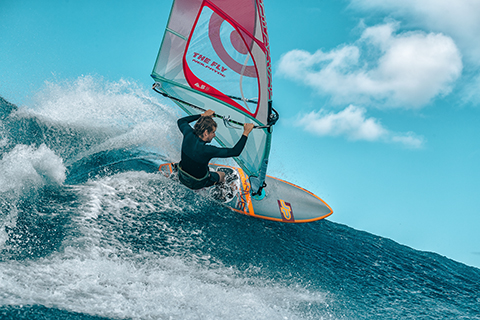
MORGAN NOIREAUX’S TUNING TIPS
I think the only time I prefer thrusters to quads is when it’s really light and onshore. I think Sylt would be a good example of when I might prefer a thruster. I just like how quads feel under my feet and I think it suits my style of sailing better. I like the ‘looseness’ that they offer, along with the fact that they still manage to have a lot of grip. Whenever I get a new board I do spend a lot time making sure I’m happy with where my fins are. Over the years I’ve found where my fins usually work the best. In general my front fins don’t move. I’ve never had much success moving them, so they stay put in the middle position. I play more with the back fins. If I measure from the back of the board to the back of the fins, 22 cm seems to be the magic number for me. So now I start with my fins there and move them around from that position. Depending on the volume of the board it changes a bit, but it’s usually pretty close. I think not moving my front fins too much makes the process a lot more straightforward. For me it’s about finding that balance where I can control the release of my fins – to be able to turn really hard without spinning out, while also being able to release the fins easily if I want. Moving fins back gives the board more grip, while moving the fins forward gives more release.
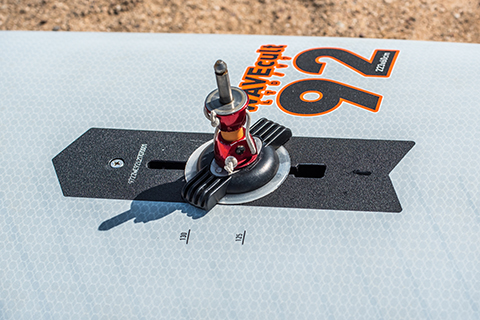
MASTFOOT TUNING
To get a feel of where your mastfoot should be you can make a mark on your mast track by taking a measure from the back of the board to 130 cm from the tail, or use (double check) the markings that might already be available. Small movements in the range of 125-132 cm can often yield excellent results. It is worth noting that riders often move their mastfeet forward, but less often rearward for good effect. Also moving your mastfoot back will require you to pull the kit down into the water more, often with a bent back leg. Therefore you are required to improve your technique to benefit from the looser feel and more available speed and response of a more aft mastfoot. On the other end of the scale, when it is blowing hard, simply moving your mastfoot forward 1-2 cm can make a huge difference in control, as this drops the nose and your body position. Essentially the feelings of moving your mastfoot are: forwards feels like you have more weight on the board so it will feel like it is more planted, grippy and settled and backwards feels like the board has more release, looseness, release and excitement. You may also feel the board is somewhat freer and faster.
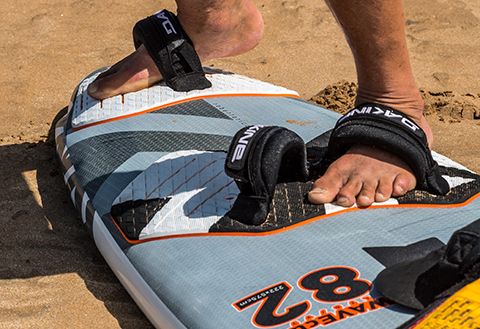
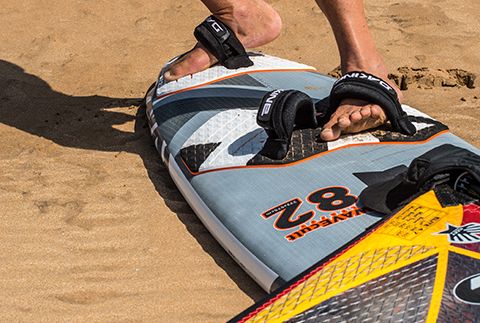
FOOTSTRAP SIZE
I hope by now you have understood that I recommend bigger, generous sized, footstraps. These pics illustrate the amount of ankle bending that a bigger strap can give you so you can drive hard both off the front foot and the back foot. The bigger strap also means you can bail the board in the air more easily and get your feet out quickly when getting washed.
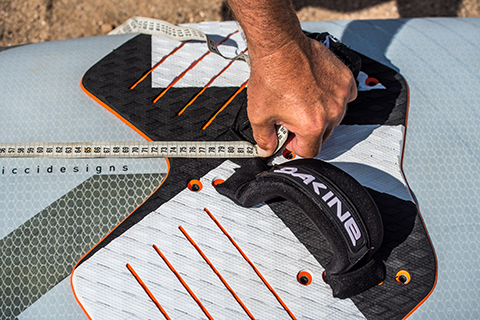
FOOTSTRAP POSITIONS
The front footstrap block can have a huge variation in placement between different boards, brands and styles of board. The choice of positions can also be wide with some blocks being 5 holes at 10 cm, whilst others are often 4 holes at 4 cm. Therefore, I like to measure from the tail and see where a measurement of 78-84 cm is and how it tallies with the actual block. I have found that mainly I like my front strap to be at around 82 cm from the tail. After establishing this I can then measure and choose my footstrap spread. In general a heavier rider might want their front strap more forward to keep the board flat and a lighter rider often favours the straps a bit further back to get more leverage and be able to turn the board. In bigger waves and with more wind and wave power a rider might move their straps forward. If you wish to turn tighter or get more looseness out of a board you can consider bringing your straps back.
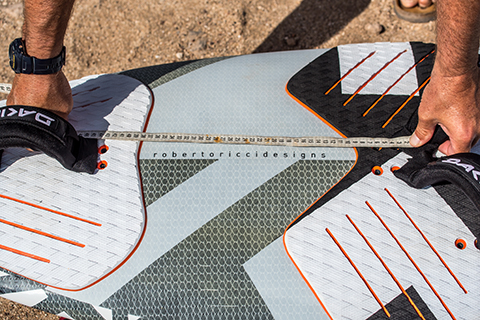
FOOTSTRAP SPREAD
The strap spread that works best for you comes from your stature and preference. Measure from the back of the front footstrap screw to the front of the back footstrap screw. As a guide the range is around 38-46 cm. Shorter (height and/or leg length) riders suit a narrower spread and taller riders go wider. For a point of reference this might be the front strap being on #2 or #3 hole (from the front) and the back one on #2 or #3 hole for me, as per the picture and with my favoured wave spread of around 45 cm. (I am 6’1” / and 91 kilos.) Experimentation and knowing the measurements is key. NOTE: Some boards will not allow you to get your required spread on all of their footstrap options so ensure you have the right board for you. A tall rider might not be able to get their wide spread and a shorter rider may be stuck with a less favoured overly wide spread!
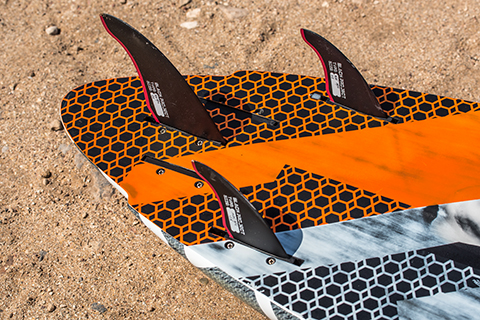
TRI-FIN SETUP
This is my favoured setup on my 92 litre RRD Cult wave board. I have a choice of 5 boxes and might go quad in bigger, or faster waves, but in the main I favour a tri-fin setup on this board. The fins are relatively forward in their boxes to get the board flying. If I want a looser feel I would move the back fin forward and for more grip and stability I would move the back fin back. Moving your side fins forward can have the effect of lifting the nose and also increasing the ‘looseness’. I have found that I favour 11.5cm outer fins for my tri-fin set and then I go between a 17.5cm for most sessions, or a 18.5cm for more lift and with bigger sails and then down to a 16.5cm for super looseness or more control when well powered.
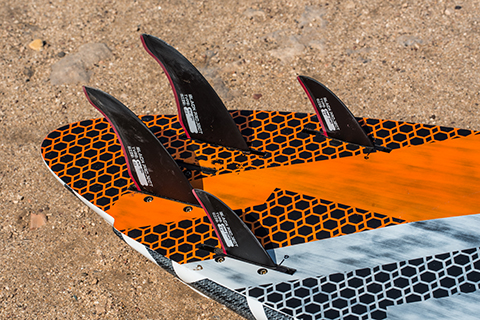
QUAD FINS
With my choice of 5 boxes, and knowing that my Cults are quite quick and release well, I go for a quad set on my 82, as this gives me looseness but also good grip. It is also a great setup for when I am very overpowered, like on a windy trip to Moulay, as I get more control so I can sail faster, hold more speed and keep the sail light and feel confident going into, and landing from, jumps. I go between 9 & 10 cm on the outside & 15.5 cm in the middle. You can see in the pic that I have marked where to put the leading edge of my quad fins, so I can do this when changing back and forth from my tri-fins. I start with the front fins in the middle of the outside box and then move the back fins around. Moving them forward will loosen it up, back will give it more drive.
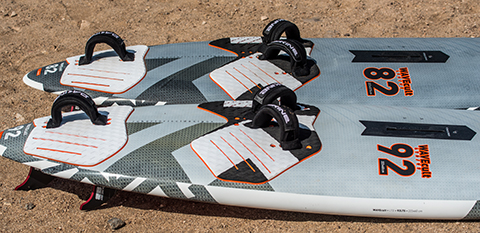
SETUP COMPARISONS
Here are my 2 most used sizes of wave board, a 92 and an 82. I like to use a 104 in some spots where there is a lot of float and ride, but in the main the 92 and 82 have a great range. I have the 92 configured for more speed and want it to turn tight so I have brought the straps back and gone for a tri-fin setup. With the 82, and me being a big unit, I am often well powered when on this so have the straps forward for more control and drive and I favour the quad set on this, unless the waves are small, more onshore or if I have less power.
CASE STUDIES
When coaching I often ask people if they have made any tuning changes before their session or throughout the day, or what tuning they might employ in the next session as we discuss their individual targets. It is important they understand the options they have and can take. Allied to this I observe certain scenarios where the kit behaves a certain way and then feedback to the rider, after a land or video debrief, and help them to understand what is going on and what they can change. Here are some examples:
• Situation: Board is lifting, can’t get enough speed and riding / gybing seems stiff.
Solution: Rider is overpowered and / or perhaps their centre fin (tri-fin setup) is too big. First we check the sail trim and ensure this is set flat enough, and that the boom is not too high! Next I suggest sizing down the centre fin in order to decrease the fin lift and help the board become more controllable and easier to carve. Lastly, if they have the option, they can consider trying a quad set, as they can give more control. COACH NOTE: Technique tip for this situation is pull down on the boom, flex the back leg and drop your elbows. Speed will keep the sail lighter so try to achieve it when you can.
• Situation: A rider is looking to get planing, keep speed, get upwind and make a few jumps on the way out, yet the board will not keep enough speed to achieve all of the above.
Solution: First we always look at sail trim, could some tension be let off, or the boom raised slightly. Or it may be that either the entire tri-fin set is not big enough and we need to size up the thruster fins, or the centre fin. In some cases it can be both! In some instances it can also be that moving the fins forward in their boxes can help the board lift and fly too. COACH NOTE: Technique is also key here; bear away to get speed and absorb the bumps and learn to plane from the straps, pulling down hard on the boom with a very flexed back leg.
• Situation: A more experienced rider is riding waves fairly well and is looking to get more vertical up the wave and perhaps get some more release in their top turns.
Solution: I would suggest here to size down the back fin, or just nudge the back centre fin forward a cm. or two. We can also look at the footstrap
positions as they may be too far forward, or perhaps the back strap is not far enough back so they can’t drive off the tail. Last easy fix is to nudge the mast foot back a cm or two.
• Situation: A rider is flying around in a fast, great stance but the board is not at the speed it should be and is catching around the shoulders (in front of the mast foot). It is also pushing too much water whilst riding and not really getting proper height whilst jumping.
Solution: Modern wave boards are just so well behaved that sometimes they are just too flat to the water and we need to release them. In this instance I would urge the rider to move the mast foot back. The rider may have also fallen for that old tuning classic of ‘put it in the middle.’ Note that sometimes your best mastfoot setting may be at the back of the mast track. COACH NOTE: If you want to sail faster and improve more and benefit from ‘looser’ turns, plus more pop in your jumps, then experiment with bringing your mastfoot back. This will also force us to pull down more on the front arm and flex the back leg in order to keep the board flat for planing and control.
These are all general rules and you must research, tune and reflect to find the optimum setting. It is also well worth marking out favoured positions on your board and to take notes as to what tuning you made and what effect you felt so you have these notes to hand for your next session.
“ In tuning the goal is experimenting to find out what works best for YOU.”
RRD boards, wetsuits & soft wear, Ezzy Sails & Black Project fins sponsor Jem Hall. Get him live and direct on one of his highly acclaimed coaching holidays but be quick as they are selling out – check out his fab new site www.jemhall.com for details. You can also follow him on twitter/Facebook/Instagram.
www.jemhall.com
